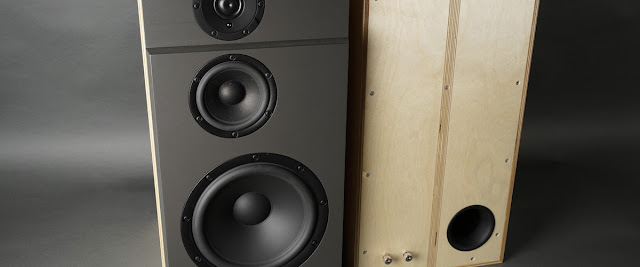The 3-Way Retro, update 1.
This build has been quite an explorative journey. I am pretty pleased with the end result but it has left me with mixed feelings. Not the speakers, they are pretty solid its the DSP. But lets start with the speakers.
This is a measurement taken from 1 meter in the middle of the room. That is equal distance to ceiling and floor with more than 2 meters to the closest wall. Note the notches at 40 and 130 Hz. I know this speaker would measure quite flat if I would measure it outside so this is the room right?
I made this speaker with the intent of placing it low and close to the floor. This is how it measure from one meter, in room, at its "feet" and pushed all the way up against the wall.
And finally measurements from my listening position some 4 meters away.
That is one really bad notch at 42 Hz, 20 dB! Is it even possible to remove it with some EQ? This is where I ran in to some serious problems. What am I trying to achieve? I know I can get this pair of speakers to measure really well but will I manage to counter the room effect even with a DSP? I really recommend reading the article My Room’s Frequency Response Seems Very Uneven by Jesco at Acoustics Insider. Some might disagree but I think it is pretty spot on.
EQ away a 20 dB dip is hard or even impossible. And it would be for one specific position, what about all other listening positions? Moving my listening chair a bit is easy. Maybe a DSP was not such a good idea after all? This is where I mixed up my plans a bit. Why not use the DSP to better the response as I would usually tweak a crossover instead of trying to room correct my listening position?
This is how the LF part measures in room from one meter with speakers on their feet pushed agains the wall. Measured from left and right position just to compare evenness. Not much of a difference.
Not bad bit this could have been achieved with a simple op-amp based filter. Now enter the SigmaStudio Automatic Speaker EQ. This is a measurement where I used a -1 dB/oct target as in my 3WC build.
Making a passive or op-amp based filter with the result above would take time and effort. Automatic Speaker EQ makes it easy and I can do it as many times as I like with no recurring cost. And I can redo it if the room changes. This is the true power of the DSP, flexibility and cost efficiency.
I am still a bit sceptic mostly because the DSP is digital and I mostly listening to analog sources. Introducing a A/D to D/A conversion by a cheap ADAU1701 board doesn't feel right. The gain structure of my preamp and the DSP is also sub optimal. What I really should do is to keep my system analog or go all in and build a whole integrated amp around a DSP. Doing as much as possible in the digital domain. Time to buy another DSP board and explore some more...













